
Volume 43 - Spring 2017
The Conservation of Sacred Dramas
Tomorrow's Past - A Modern Interpretation of a Conservation Binding - by Kathy Abbott
This article first appeared in the 2016 edition of 'Bookbinder' and appears here with the kind permission of its author Kathy Abbott and the Society of Bookbinders.
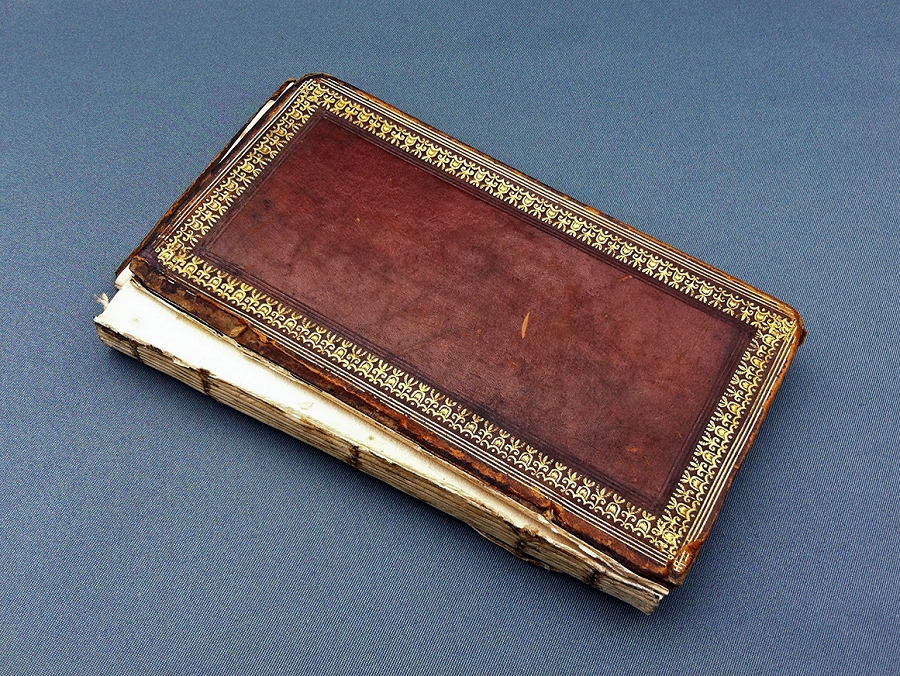
Fig 1 - The book before Treatment
Introduction
Tomorrow's Past was founded in 2003 as a small international group of bookbinders who make modern conservation bindings for antiquarian books. The number of bookbinders involved with the group has remained fairly constant - between ten and twelve binders from the UK, Italy, France, the Netherlands, and others as invited. The most regular core of bookbinders, apart from myself, has been: Carmencho Arregui (Italy); Cristina Balbiano d'Aramengo (Italy); Sü n Evrard (France); Charles Gledhill (UK); Peter Jones (UK); Katinka Keus (Netherlands); Jen Lindsay (UK), and Tracey Rowledge (UK). The most recent contributors are Sol Rebora (Argentina) and Suzanne Schmollgruber (Switzerland). All of us work professionally as bookbinders, some as teachers, and most handle books of many different types and periods in their everyday work.
The group's name originates in Edgar Mansfield's dictum, "Surely it is better to create tomorrow's past than to repeat today's".¹ Our work is intended to challenge traditional approaches to book conservation and restoration by embracing current conservation ethics, creating an alternative approach which is constantly evolving. We only work on books that are in need of repair, protection, or rebinding: we do not disturb perfectly good bindings for the sake of the project. As well as being based on good conservation practice, the work of Tomorrow's Past is strongly, but subtly, design-led. However, our aim is always to put the needs of the book first and to make our work without ego. Tomorrow's Past bindings must be fully reversible and are often made without the use of adhesives. We always document what we have done in the process of repair or rebinding.
This fusion of experience and historical awareness with modern conservation materials, techniques, and skill has produced work which is radical in its simplicity, ingenuity, and truth to materials.
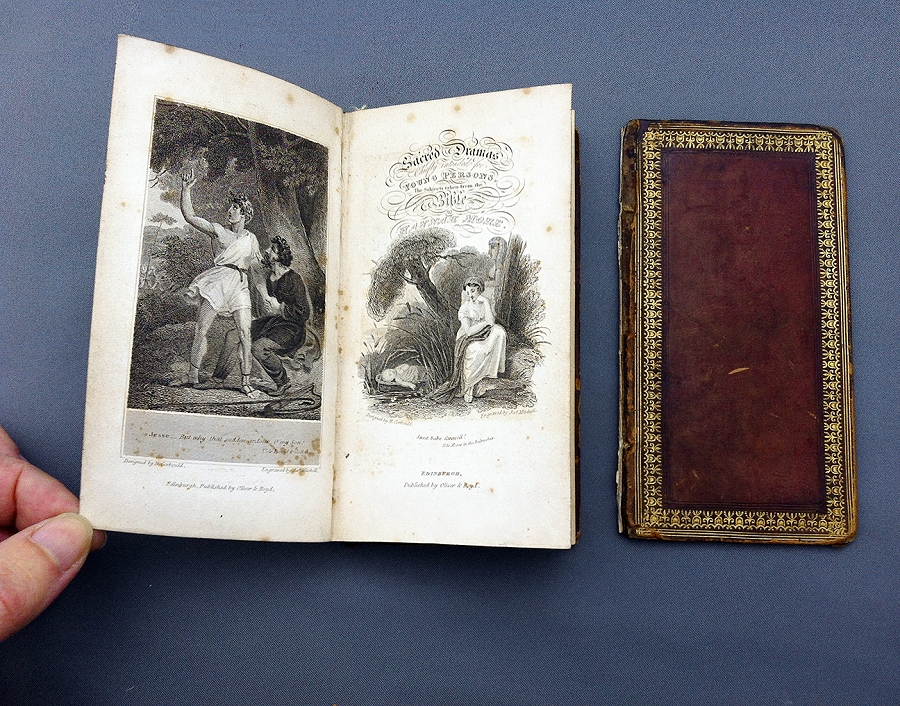
Fig 2 - Frontpiece, title page and detached board
The Binding
In 2013, Tomorrow's Past was invited to exhibit at the Aram Gallery, London, from November of that year to January 2014. This was the first time our work was to be exhibited in a non-book-related context. The Aram Gallery is situated on the top floor of Aram Store, a retail space selling top-end designer furniture and products. The gallery focuses on showing work of emerging designers, with specific emphasis on the experimental and the new. This was a hugely exciting prospect for us because our work was being judged purely on its design and function, and experimentation in the field of conservation.
The book I chose to work on for the exhibition was Hannah More's Sacred Dramas (c.1818), a collection of bible stories for children. The book itself was in reasonably good condition: the pages were foxed but undamaged, and the sewing intact, but the boards were detached (with the endpapers still attached to them) and there was no spine, making it suitable for a Tomorrow's-Past-style treatment (figs. 1 & 2).
The key things that inspired my design choices were the colours used in the edge marbling and in the marbled endpapers, and also the unusual decorative roll used in the gold tooling. I spent a lot of time just looking at and handling the book, diagnosing its problems and needs, and thinking about the best way of reconnecting the component parts. The book did not need to be resewn as the sewing was perfectly intact; also I did not want to disturb the marbled edges. The leather on the boards was a tiny bit scuffed but otherwise in good condition except for the corners which were 'bald' and bumped.
I knew I did not want to undertake a standard leather reback on this book as, although I do these often in my working practice, leather is not particularly strong in the joint area and it is often where books break down. This one was a good example. Book restorers and conservators generally need to reattach boards with linen or cotton and then reback with leather, giving two covering materials over the joint. On small books this sometimes feels like overkill, but leather alone often isn't strong enough to withstand centuries of constant opening and closing. I love the way the joint functions when detached boards are reattached with cotton or linen: they open freely, right back onto themselves, and are incredibly stable and strong. So for this small book (134 x 77 x 14mm), I thought it best to use cotton alone. However, I did not want the cotton to show pure white at the joint area and this got me thinking.....
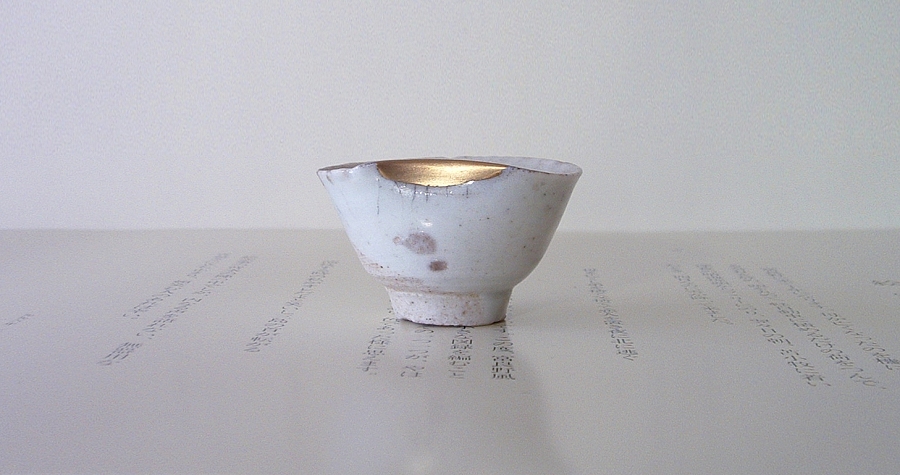
fig 3 - Kintsugi porcelain repair
For the previous Tomorrow's Past exhibition in 2011 I had repaired a broken book using the principles of Japanese Kintsugi porcelain repair. This was Q. Horatii Flacci Carmina Expurgata (1784) which was in its original eighteenth-century Italian carte rustica binding. In the Kintsugi technique, broken or chipped pieces of ceramic are repaired with lacquer and then the repairs are decorated with gold or silver powder, often rendering the piece more beautiful than it was before the accident (fig 3).
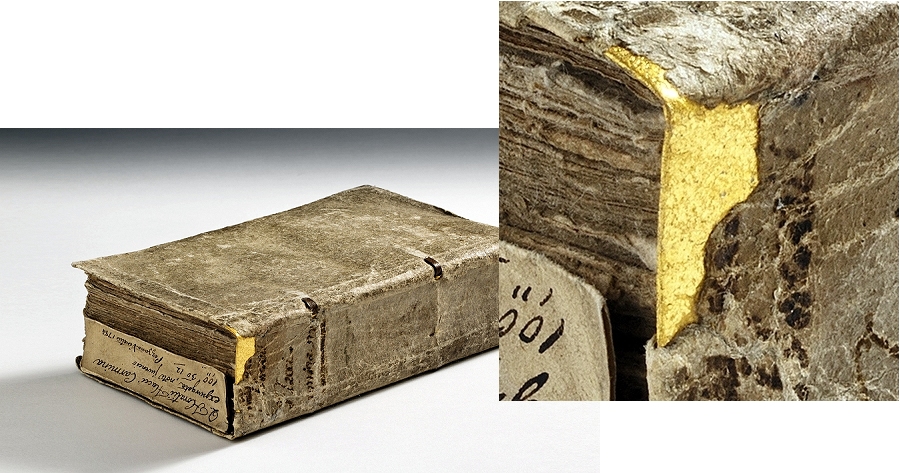
fig 4 - Q. Horatii Flacci Carmina Expurgata (1784)
On Horatii, I repaired all missing pieces of the book with gilded handmade paper, thus highlighting the repairs in much the same way (fig 4).
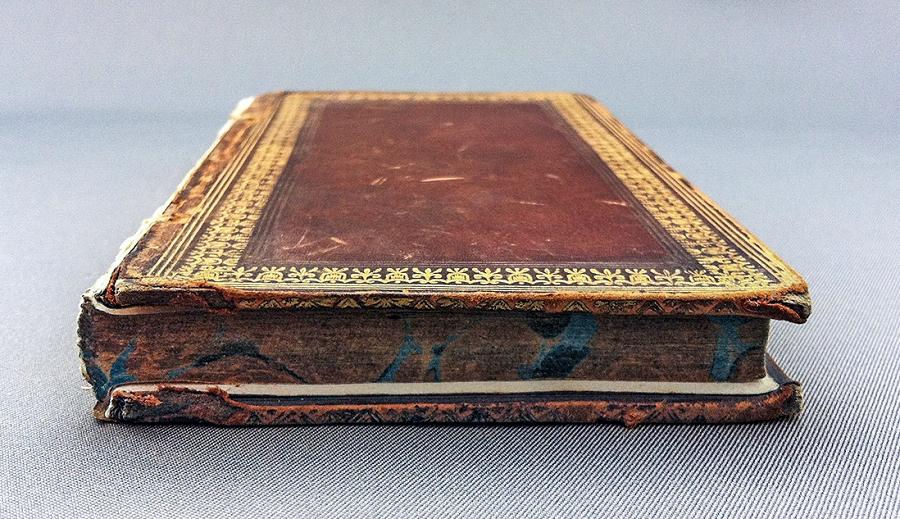
fig 5 - The marbled edge
On Sacred Dramas I decided to revisit that idea, highlighting the repairs not with gold this time but a colour. For the cotton joints I trialled lots of colours, quite subtle ones at first, before realizing that the strong blue in the edge marbling was the right one (fig 5).
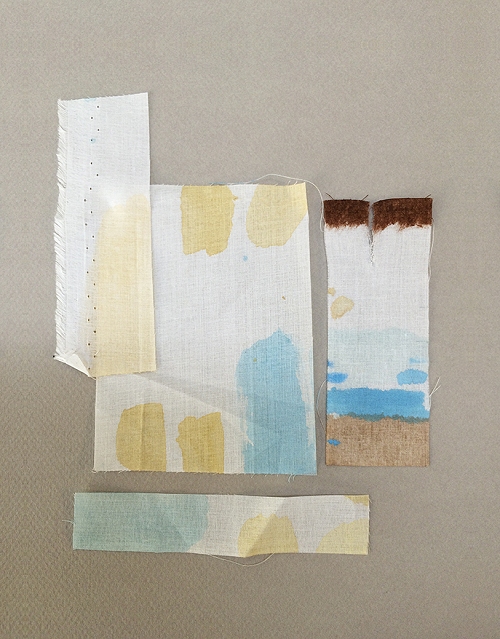
fig 6 - Cotton joints colour trials
I painted the cotton with a thin coat of blue acrylic wash, to the exact colour of the marbling, but against the leather it just looked dull and a bit insignificant. It only looked right when the colour was a little brighter than the blue in the edge marbling (fig 6).
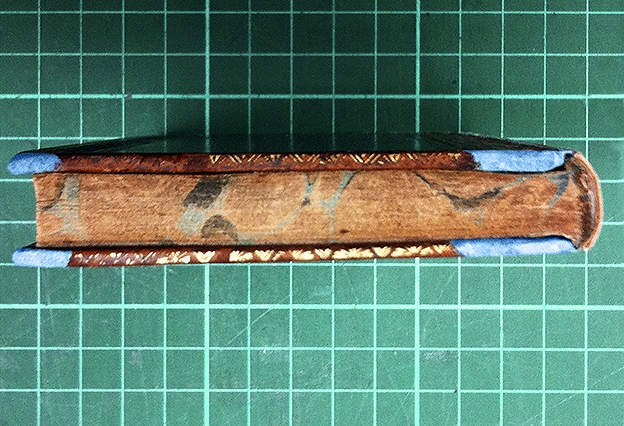
fig 7 - Japanese tissue repairs
Once this was decided, I coloured some Japanese Kozo-shi tissue to the same blue to repair the bald areas on the board edges and corners. The colour was 'fixed' with a thin coat of methylcellulose. I consolidated the corners of the boards with paste and let them harden before needle cutting the repair pieces of Japanese tissue. The tissue was applied to the bald corners and board edges with handmade paste (fig 7).
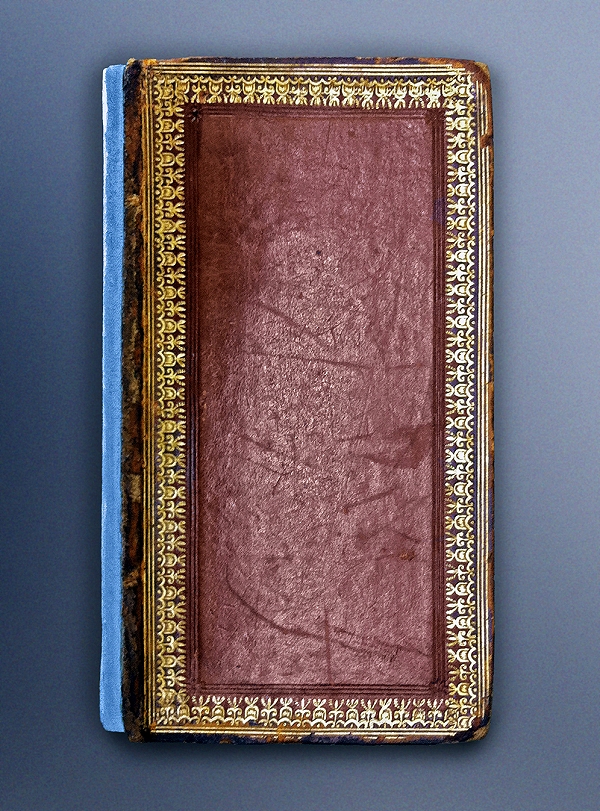
fig 8 - Board attachment with coloured cotton
To reattach the boards, the coloured cotton was inserted and adhered underneath the endpapers, which were still attached to the boards, up the joint edge of the boards so that the board articulated from the top of the joint, and halfway across the spine, so that the cotton met in the middle of the spine (fig 8). The adhesive used was a 50% EVA and 50% methylcellulose mix.
The next decision was what sort of spine covering the book should have. I wanted to retain as good an opening as was possible with this book - it had been sewn on recessed cords and did not open very well. I thought it should have a hollow, but did not want a spine covering that would restrict the beautiful opening I had achieved with the cotton joints, so I decided to make a decorative hollow. I made some trials of hollows and decided on a one-on-two-off construction, but felt the cut edge of the traditional hollow would be a bit vulnerable as a spine piece.
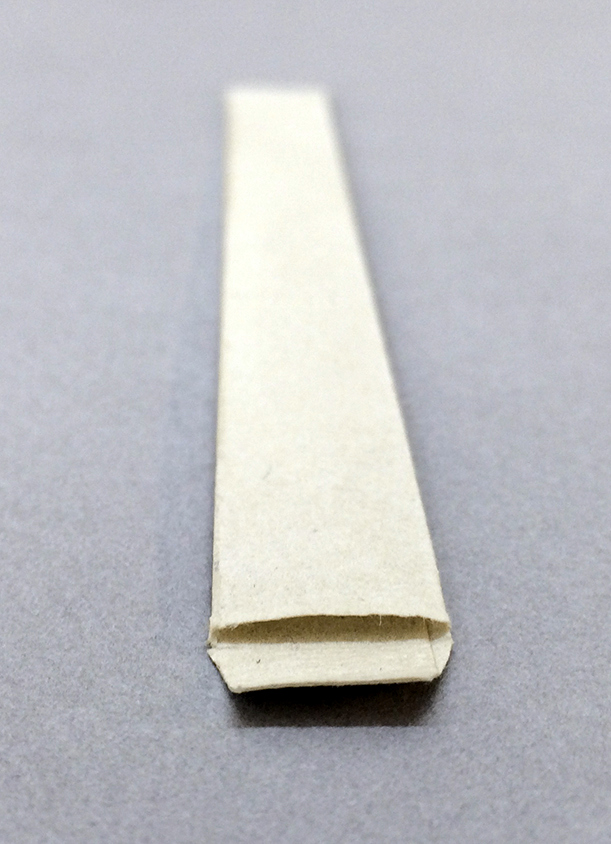
fig 9 - Hollow with small flap
So I decided to make one with a small flap that would tuck down into it, sealing the top and bottom edges (fig 9). With the structure of the spine piece decided, I could get on with the fun bit of designing the spine.
As I mentioned earlier, I was very attracted to the gold tooling on the boards and wanted the spine to have a relationship with the tooling in some way. Firstly, I coloured some handmade paper with acrylic paint to match the soft brown of the book's edges. This was to be the background colour. I then set about experimenting with different ideas for the pattern. I made a rubber stamp with a similar design to the gold tooling but, even after several trials, it didn't work - it just wasn't sharp enough. The only way to achieve the sharpness I wanted was to draw directly onto the coloured handmade paper.
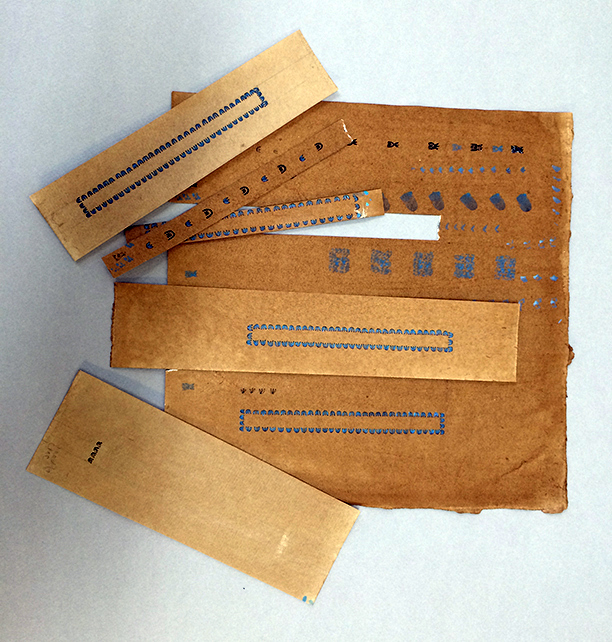
fig 10 - Pattern Trials
Apart from conservation dyes, acrylic inks and paint are the only stable medium for colouring. Watercolour and gouache are fugitive, so not suitable. I filled a 0.3mm Rotring pen with black acrylic ink and then drew my shapes freehand to fit within the size of the spine covering. Once dry, I hand-painted the shapes with the same blue acrylic used in the cotton joint and Japanese tissue repairs. I did a quite a few versions of the pattern before choosing the ideal one, and had some reserves in case of any mistakes with making the hollow back (fig 10). Each of the spine pieces was sealed with methylcellulose.
The hollow back was made using the same EVA/methylcellulose mix as I used to reattach the boards, and was attached to the spine of the book using pure EVA.
Conclusion
Throughout the process of conserving this book I felt that I was being led in a direction that didn't feel wholly comfortable to me: it was a very instinctive process. The decisions I made had their origins in the book restoration and conservation work that I do on a daily basis. This background enabled me to make sound decisions about structure, engineering, and conservation. I still don't know if I actually like this binding now that it is completed, but I do know that it is 'right' (fig 11). Its reception has been very mixed - people seem to either love it or hate it!
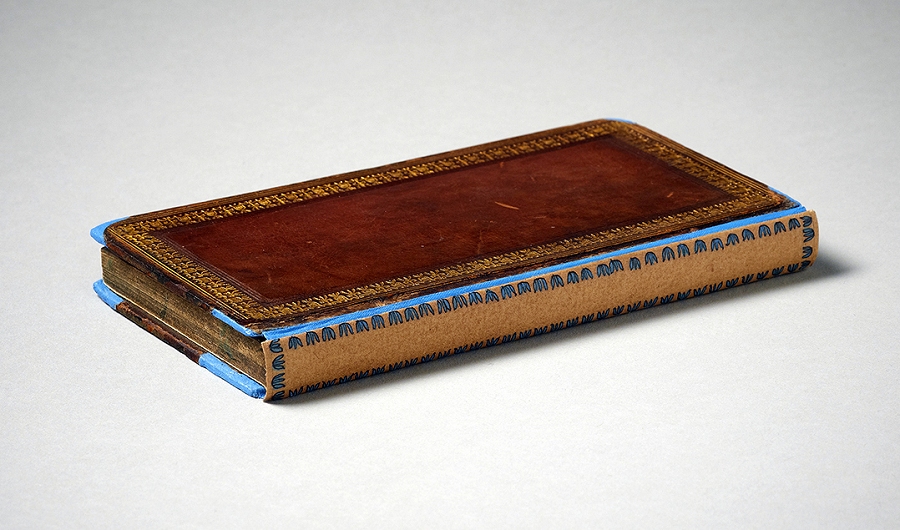
fig 11 - The finished book
Sacred Dramas was included in the Aram Gallery exhibition, and then was selected to be shown - along with Horatii - at the Lodz Design Festival in Poland in the autumn of 2014. The Lodz exhibition was called 'Brave Fixed World', and showcased projects that 'interrogate technical, philosophical and aesthetic approaches and attitudes to repair'. These were the only two books to feature at this huge heavily design-based festival - something that I feel very proud of.
Note - ¹ Edgar Mansfield (1907 - 1996) was a bookbinder and sculptor.

Kathy Abbott served a four-year apprenticeship in bookbinding and then gained a Higher National Diploma from the London College of Printing, followed by a BA (Hons) degree in Bookbinding from Roehampton University, Surrey. She teaches advanced level Fine Binding at the City Lit in London and conducts bookbinding workshops across the UK and overseas. She is a partner with Tracey Rowledge in Benchmark Bindery, established in 2009, a founder member of the group Tomorrow's Past, and the author of Bookbinding: A step-by-step guide, published by the Crowood Press in 2010.
